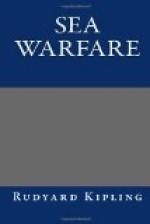“What are the destroyers doing just now?” I asked.
“Oh—running about—much the same as usual.”
The Navy hasn’t the least objection to telling one everything that it is doing. Unfortunately, it speaks its own language, which is incomprehensible to the civilian. But you will find it all in “The Channel Pilot” and “The Riddle of the Sands.”
It is a foul coast, hairy with currents and rips, and mottled with shoals and rocks. Practically the same men hold on here in the same ships, with much the same crews, for months and months. A most senior officer told me that they were “good boys”—on reflection, “quite good boys”—but neither he nor the flags on his chart explained how they managed their lightless, unmarked navigations through black night, blinding rain, and the crazy, rebounding North Sea gales. They themselves ascribe it to Joss that they have not piled up their ships a hundred times.
“I expect it must be because we’re always dodging about over the same ground. One gets to smell it. We’ve bumped pretty hard, of course, but we haven’t expended much up to date. You never know your luck on patrol, though.”
THE NATURE OF THE BEAST
Personally, though they have been true friends to me, I loathe destroyers, and all the raw, racking, ricochetting life that goes with them—the smell of the wet “lammies” and damp wardroom cushions; the galley-chimney smoking out the bridge; the obstacle-strewn deck; and the pervading beastliness of oil, grit, and greasy iron. Even at moorings they shiver and sidle like half-backed horses. At sea they will neither rise up and fly clear like the hydroplanes, nor dive and be done with it like the submarines, but imitate the vices of both. A scientist of the lower deck describes them as: “Half switchback, half water-chute, and Hell continuous.” Their only merit, from a landsman’s point of view, is that they can crumple themselves up from stem to bridge and (I have seen it) still get home. But one does not breathe these compliments to their commanders. Other destroyers may be—they will point them out to you—poisonous bags of tricks, but their own command—never! Is she high-bowed? That is the only type which over-rides the seas instead of smothering. Is she low? Low bows glide through the water where




